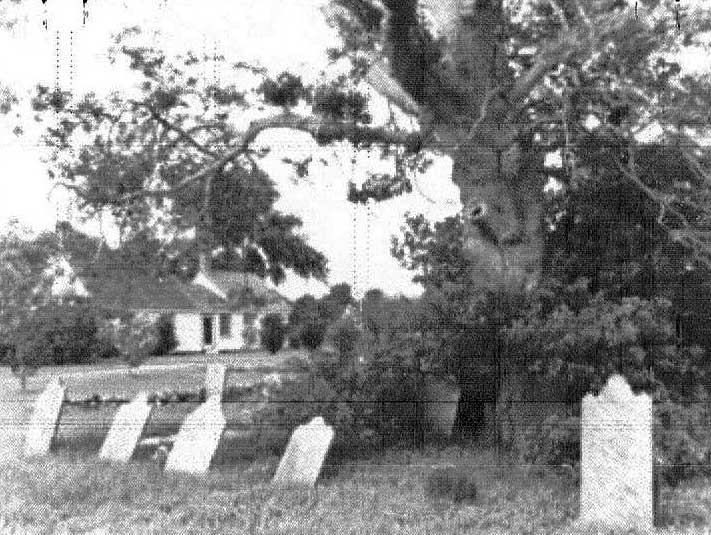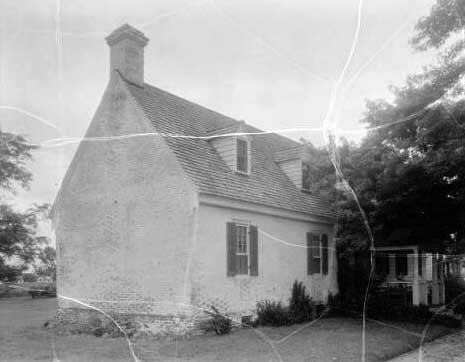Historical Reminiscing with Robert B. Hitchings
Unusual Happenings and a Ghost Story
Copyright. All rights reserved.
 Warwick Family Cemetery |
 Warwick Plantation |
Several months ago I was visiting my good friend and remote cousin, Nancy W. Garrett, a genealogist and historian on the Eastern Shore. Nancy sponsored me when I joined the Jamestown Society and the Order of the Crown of Charlemange. One thing I have learned in life is that one learns from our fellow historians. Nancy is no exception. In the 1980's she did a program on the Ghost of the Eastern Shore for a group of her DAR friends. In fact she gave me a copy of her program of different stories.
One such story that really intrigued me was about the Upshur family because I am related remotely to them. I guess this is why I liked this story. The early Hitchins settled in Accomack county during the 1670’s.
In Accomack County on the Eastern Shore lies a very old home called Warwick Plantation, later in the 19th century called Quinby farm, the ancestral home of the Upshur Family. In the back yard is the family plot of very old tombstones. One tombstone is that of Rachel Revell Upshur whose inscription reads, “In memory of Rachel the wife of Abel Upshur who died December 25th 1749 in the 47th year of her age.” Who was Rachel and what happened to Rachel?
Rachel was the daughter of John and Agnes Burton Revell. She was born on her father’s plantation on Pungoteague Creek on the bay side of Accomack County. She was the wife of Abel Upshur, marrying him about 1725.
Able Upshur was one of the leading Eastern Shore citizens of his time. He never held political office but was appointed on numerous committees and guardian of various orphans or minors. One has to remember that many times plagues and disease left children as orphans and people like Upshur would see where these poor orphans would go and in handling their estates.
Able Upshur was part of the landed gentry and he was a man of considerable means. He also owned Cedar Grove, another prosperous plantation on the shore.
The book, Upshur Family in Virginia by John Andrews Upshur (Dietz Press, Richmond, Va. 1955) tells the story of this family that migrated from England in the late 1650's. This is the story of Rachel’s death that has been handed down in the Upshur family from generation to generation.“On a bleak December night in 1749, Able Upshur was aroused from sleep by the squawking of hens in the nearby fowl house. He climbed out of bed and hurried into the yard to investage the disturbance. It was a cold night and Able had not been well. Rachel being concerned about his health slipped a robe over her nightdress and went out to beg Able to return. She found her husband standing near the fowl house, and he told her that he had been unable to discover anything usual although the fowls seemed much frightened. Together they returned to their doorstep where Rachael, standing in her bare feet, gently pushed Able into the house with the admonition that he should not stay out another minute lest he catch his death of cold. Rachel paused a moment on the millstone at the foot of the steps, and hearing no further disturbance she turned to follow Abel into the house. At that instant a red fox affected with rabies came from under the steps and bit Rachel on the heel. Blood fell on the millstone. Nine days later she was seized with hydrophobia and died soon thereafter on Christmas night, being smothered between two feather beds, an old time precaution which was taken to guard against this so affected.”
Today, the millstone is still there at Warwick House reminding many folks of the awful tragedy that hit Rachel. Interestingly, the gray millstone is still there, but when it rains a splotch of red can still be seen today.
After Rachel Upshur was smothered to death to end her agonizing sufferings from a rabid fox, she was buried near the plantation house. Later, her husband Able planted a holly tree at the head of her stone. Four years after Rachel’s death he was buried next to his beloved wife. Years later the tree grew to such proportion that it separated and lifted Rachel’s tombstone from the ground.
According to my cousin Nancy, there is no haunting. Maybe Rachel just wanted peace after her horrible ordeal. However, the millstone is still present for all to see today.
An Unusual Ghost Story – The Howling of the Great Blue Dog.
Many years ago I remember reading George Tucker’s story about the Blue Ghost Dog back in the early 1960s.
Americans love ghost stories, but unfortunately this story is not part of our Old Dominion folk lore, but of the state of Maryland.
The setting is in Charles City County, Maryland, a small place called Port Tobacco, once a bustling prosperous town. Settled in 1634, this was once Maryland’s largest seaport. The town served as the seat of Charles City County from 1727-1895. Like all seaports they had a number of taverns throughout and many travelers and seafaring men sought out these taverns or grog shops along the waterfront. It was here three hundred years ago our Ghost story begins.
One evening an old man, a peddler, walked into a tavern with his large fierce dog and loudly called for a few drinks. He met a few strangers and got acquainted and throughout the night they all got a wee bit drunk. The old man showed his new found friends his gold coins from his old money belt. As the evening progressed, the peddler already intoxicated, was bragging about his gold. Another tale is that he took off his money belt and several gold coins spilled out onto the wooden table, which stirred the interest of these new-found friends.
Soon his new found friends left the tavern and the old peddler was alone with his faithful dog. A few hours later, quite intoxicated, the peddler and his large fierce dog decide to leave the tavern. He staggered out in the cold February moonlight with his faithful dog by his side.
The next day the old peddler was found dead along the old road. He was robbed and murdered. His faithful dog tried to protect him and he too was killed by the robbers. But the story does not end here.
It has been over 300 years and every February on a cold moonlight night, the locals still talk of a large Blue Dog that appears annually, and, if you listen carefully, you may hear the old dog howling in the night trying to protect his master.* * * * * * * * *
Robert B. Hitchings is a seventh generation Norfolk resident, graduating with an Associate's Degree in Biology from Old Dominion University and BA in history from Virginia Wesleyan University. During his studies he was awarded a scholarship at Emmanuel College, Cambridge, England, and he was an exchange student at Brooks-Westminster College, Oxford, England. From 1999-2014 he worked as head of the Sargeant Memorial History Room at Norfolk Public Library, and since then has headed the Wallace History Room at Chesapeake Public Library. He is also the President of the Norfolk County Historical Society, and for six years was a columnist for The Virginian-Pilot. Robert may be reached at nchs.wallaceroom@gmail.com